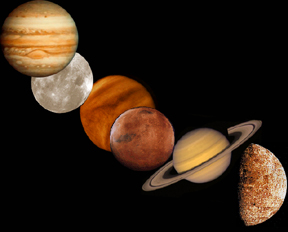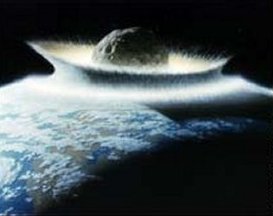This is an artist's depiction of an asteroid colliding with Earth.
Click on image for full size
Courtesy of NASA
Scientists Track Asteroids
News story originally written on June 28, 2000
Scientists just created an asteroid map that shows over 900 asteroids that
could someday collide with Earth. Any asteroid 1 kilometer long or larger is considered
a danger. Even one of these smaller space rock could change the Earth and
possibly wipe out millions of people and animals.
Scientists suspect a large asteroid may have crashed into the Earth millions of years ago, wiping
out the dinosaurs. Fortunately, 40% of these asteroids are now known, and the computer
model used to track these should help scientists discover more. Most of these asteroids are in the belt
between Mars and Jupiter. The problem arrives when two or more of these rocks crash into each other, sending one or more off orbit and maybe towards Earth.
As of right now, we can only predict up to 100 years into the future. So unfortunately,
we can't look for possible incidents way into the future. Even still, scientists say this is a great start to
protecting our planet from another collision.
You might also be interested in:

It was another exciting and frustrating year for the space science program. It seemed that every step forward led to one backwards. Either way, NASA led the way to a great century of discovery. Unfortunately,
...more
The Space Shuttle Discovery lifted off from Kennedy Space Center on October 29th at 2:19 p.m. EST. The weather was great as Discovery took 8 1/2 minutes to reach orbit. This was the United States' 123rd
...more
A moon was discovered orbiting the asteroid, Eugenia. This is only the second time in history that a satellite has been seen circling an asteroid. A special mirror allowed scientists to find the moon
...more
Will Russia ever put the service module for the International Space Station in space? NASA officials want an answer from the Russian government. The necessary service module is currently waiting to be
...more
A coronal mass ejection (CME) happened on the Sun early last month. The material that was thrown out from this explosion passed the ACE spacecraft. The SWICS instrument on ACE has produced a new and very
...more
J.S. Maini of the Canadian Forest Service called forests the "heart and lungs of the world." This is because forests filter air and water pollution, absorb carbon dioxide, release oxygen, and maintain
...more
In late April through mid-May 2002, all five naked-eye planets are visible at the same time in the night sky! This is includes Mercury which is generally very hard to see. You won't want to miss this!
...more















